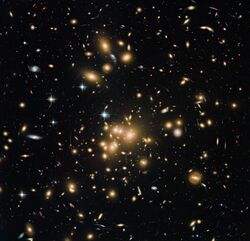Astronomy:Abell 1689
| Abell 1689 | |
|---|---|
 | |
| Observation data (Epoch J2000) | |
| Constellation(s) | Virgo |
| Right ascension | 13h 11m 34.2s[2] |
| Declination | −01° 21′ 56″ |
| Richness class | 4[3] |
| Bautz–Morgan classification | II-III[3] |
| Redshift | 0.1832[2] |
| Distance (co-moving) | 754 Mpc (2,459 Mly) h−10.705[2] |
| X-ray flux | (14.729 ± 8.1%)×10−11 erg s−1 cm−2 (0.1–2.4 keV)[2] |
Abell 1689 is a galaxy cluster in the constellation Virgo over 2.3 billion light-years away.
Details
Abell 1689 is one of the biggest and most massive galaxy clusters known and acts as a gravitational lens, distorting the images of galaxies that lie behind it.[4] It has the largest system of gravitational arcs ever found.[5]
Abell 1689 shows over 160,000 globular clusters, the largest population ever found.[6]
There is evidence of merging and gases in excess of 100 million degrees.[5] The very large mass of this cluster makes it useful for the study of dark matter and gravitational lensing.[7][8]
At the time of its discovery in 2008, one of the lensed galaxies, A1689-zD1, was the most distant galaxy found.[9][10]
Gallery
Yellow galaxies belong to the cluster itself. Red and blue are background galaxies gravitationally lensed.
See also
References
- ↑ "New Hubble image of galaxy cluster Abell 1689". ESA/Hubble Press Release. http://www.spacetelescope.org/news/heic1317/.
- ↑ 2.0 2.1 2.2 2.3 "NASA/IPAC Extragalactic Database". Results for Abell 1689. http://ned.ipac.caltech.edu/cgi-bin/nph-objsearch?objname=Abell+1689&extend=no. Retrieved 2012-03-17.
- ↑ 3.0 3.1 Abell, George O.; Corwin, Harold G. Jr.; Olowin, Ronald P. (May 1989). "A catalog of rich clusters of galaxies". Astrophysical Journal Supplement Series 70 (May 1989): 1–138. doi:10.1086/191333. ISSN 0067-0049. Bibcode: 1989ApJS...70....1A.
- ↑ Falcon-Lang, Howard (19 August 2010). "Fate of Universe revealed by galactic lens". BBC News. BBC. https://www.bbc.co.uk/news/science-environment-11030889.
- ↑ 5.0 5.1 "Purple Haze, Part Deux". NASA. 12 September 2008. http://www.nasa.gov/multimedia/imagegallery/Image_feature_1172.html.
- ↑ "Globular clusters within Abell 1689". HUBBLE/ESA. 12 September 2013. http://www.spacetelescope.org/images/heic1317b/.
- ↑ "Detailed Dark Matter Map Yields Clues to Galaxy Cluster Growth". NASA. 11 December 2010. http://www.nasa.gov/mission_pages/hubble/science/dark-matter-map.html.
- ↑ Diego, Jose M.; Broadhurst, T.; Benitez, N.; Umetsu, K.; Coe, D.; Sendra, I. et al. (2014). "A Free-Form Lensing Grid Solution for A1689 with New Multiple Images". MNRAS 446 (1): 683–704. doi:10.1093/mnras/stu2064. Bibcode: 2015MNRAS.446..683D.
- ↑ "Astronomers Eye Ultra-Young, Bright Galaxy in Early Universe". NASA. 2008-02-12. http://www.nasa.gov/centers/jpl/news/Spitzer20080212.html.
- ↑ "Astronomers Uncover One of the Youngest and Brightest Galaxies in the Early Universe". Space Telescope Science Institute Baltimore, Md. / nasa.gov. 2008-02-12. http://www.nasa.gov/mission_pages/hubble/science/young_bright.html.
External links
- Galaxy cluster Abell 1689: Biggest 'Zoom Lens' in Space Takes Hubble Deeper into the Universe (HubbleSite)
- Galaxy cluster Abell 1689: Astronomers Find One of the Youngest and Brightest Galaxies in the Early Universe (HubbleSite)
- Astronomers take a step towards revealing the Universe's biggest mystery, ESA/Hubble Press Release.
Coordinates: ![]() 13h 11m 34.2s, −01° 21′ 56″
13h 11m 34.2s, −01° 21′ 56″
 |




